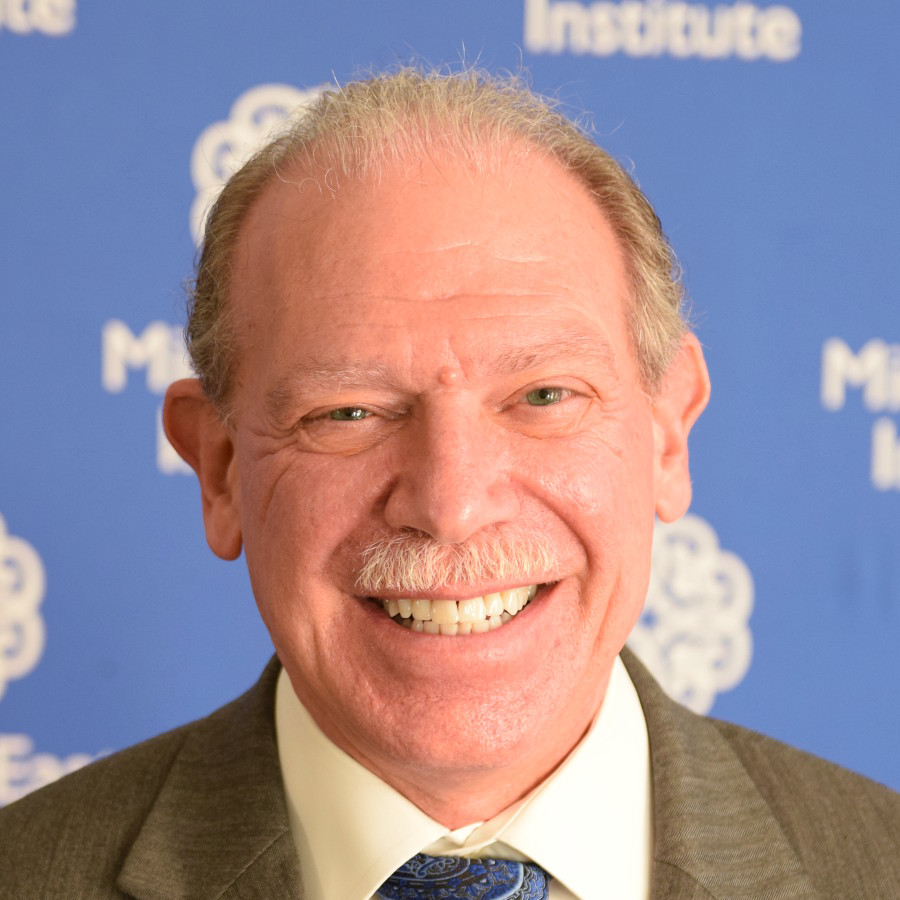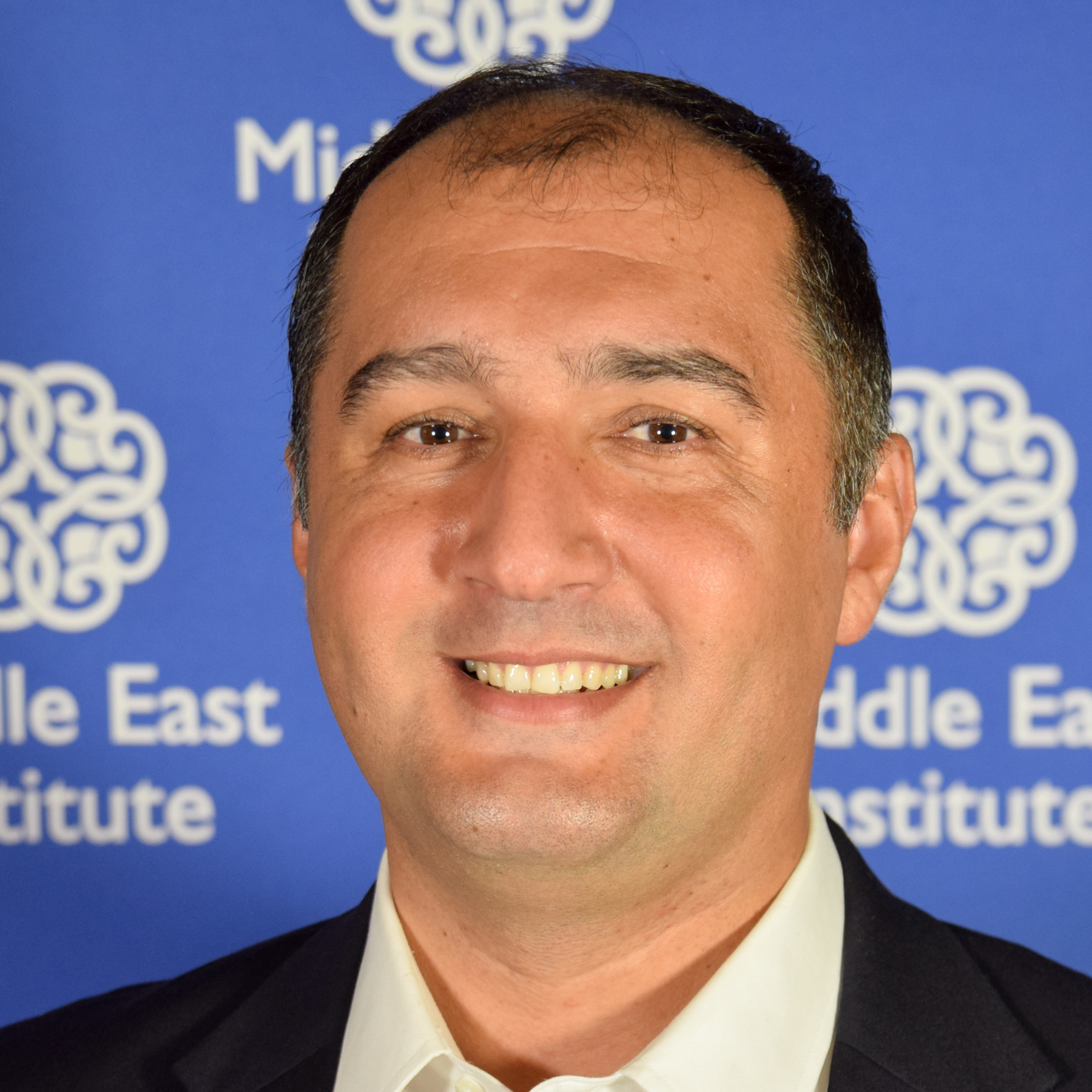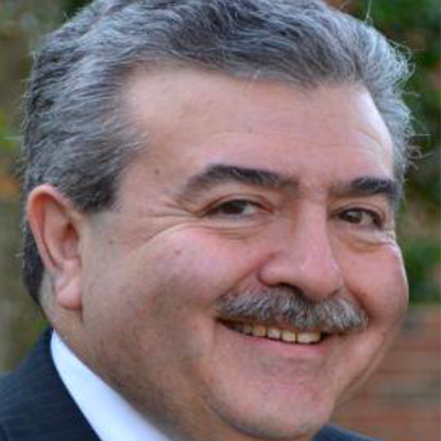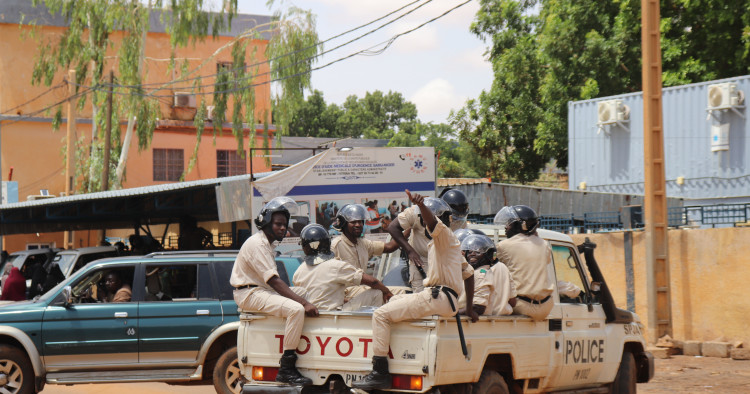Contents:
- What the Niger coup means for the fight against terrorism in the Sahel
- As Abraham Accords partners waver, Biden administration doubles down on Israeli-Saudi normalization
- Growing anxiety in Iran over access to disputed hydrocarbon fields in Gulf
- Implications for MENA of the global economy’s slow and uneven growth
What the Niger coup means for the fight against terrorism in the Sahel
Lina Raafat
Non-Resident Scholar

-
The Sahel is now considered the global epicenter of terrorism, with attacks intensifying in the past several years in the Liptako-Gourma region between Mali, Burkina Faso, and Niger due to the growth of Islamic State and al-Qaeda affiliates.
-
While it is too early to tell how the situation will unfold, a possible course-reversal at this critical juncture could jeopardize hard-won gains in the fight against jihadist insurgents in the region.
On July 26, members of Niger’s presidential guard announced on state television that they had seized power, citing concerns over the West African state’s deteriorating security situation. President Mohamed Bazoum, who was democratically elected in 2021 in Niger’s first peaceful transition of power since the country’s independence, has been a valued partner in regional and international efforts to confront the expansion of jihadist insurgencies with links to al-Qaeda and the Islamic State in the Sahel region.
The power grab has been widely condemned by international and regional bodies alike, including the United Nations, European Union, and, most notably, the African Union (AU) and the Economic Community of West African States (ECOWAS), which convened an extraordinary summit in Abuja on July 30, vowing to use all means necessary to restore the status quo ante, including force.
Concerns are growing over the potential implications of these developments for the fight against terrorism in the region. Neighboring Burkina Faso and Mali experienced military coups in August 2020 and January 2022, respectively, further destabilizing an already-fragile region. The Sahel is now considered the global epicenter of terrorism, accounting for more terrorism-related deaths in 2022 than South Asia, the Middle East, and North Africa combined. Since 2020, attacks have intensified in the Liptako-Gourma region — the tri-border area of Mali, Burkina Faso, and Niger — making it the subregional epicenter of Sahelian terrorism due to the growth of Islamic State and al-Qaeda affiliates (namely the Islamic State in the Greater Sahel, or ISGS, and Jama’at Nusrat al-Islam wal-Muslimin, or JNIM).
Notwithstanding regional challenges, Niger has strived to pursue a comprehensive counterterrorism approach. It has complemented its military response with preventative efforts that address drivers of recruitment into jihadist groups, including fostering community dialogue, brokering local peace agreements, and initiating dialogue with jihadist groups through local intermediaries. This approach has also been inspired by developments in the region following the death of Boko Haram leader Abubakar Shekau, which has resulted in unprecedented waves of mass defections, creating a unique window of opportunity for Lake Chad Basin countries to weaken the operational capacity of jihadist insurgents.
Questions are also arising regarding the fate of partner forces in the region. Following the withdrawal of the French-led Takuba forces from Mali in August 2022, and the subsequent withdrawal of French forces from Burkina Faso in February 2023, France shifted its forces to Niger. The U.S. announced $150 million in direct assistance to the country after Secretary of State Antony Blinken’s visit last March to Niamey, where over 1,000 U.S. troops are stationed. Additionally, the planned withdrawal of the U.N. stabilization force from Mali by the end of 2023 puts an end to the decade-long presence of a 17,000-strong mission and risks creating a vacuum that jihadist insurgents can further exploit.
While it is too early to tell how the situation will unfold, a possible course-reversal at this critical juncture could jeopardize hard-won gains in the fight against jihadist insurgents in the region. It also remains unclear whether a military takeover would mean a reversion to heavy-handed militarized methods rather than comprehensive approaches to countering terrorism. What is clear at this point, however, is that the Sahel region needs its partners now more than ever, with a reinvigorated focus on empowering African regional bodies like the AU and ECOWAS to lead the region during such turbulent times.
Follow on Twitter: @lina_raafat
As Abraham Accords partners waver, Biden administration doubles down on Israeli-Saudi normalization
Gerald M. Feierstein
Distinguished Sr. Fellow on U.S. Diplomacy; Director, Arabian Peninsula Affairs

-
Senior Biden administration officials continue to visit Saudi Arabia in pursuit of a potential deal to normalize relations with Israel despite little indication that the Saudis have strayed far from their adherence to the Arab Peace Initiative or that extremist elements within the Israeli government are themselves committed to normalization.
-
The real challenge for the administration should be to protect the existing Abraham Accord agreements from foundering over Israeli government actions and decisions that have ratcheted up tensions with Palestinians.
Senior Biden administration officials visiting Saudi Arabia in recent weeks, including Secretary of State Antony Blinken, National Security Advisor Jake Sullivan, and Special Presidential Coordinator Amos Hochstein, placed the issue of Saudi-Israeli normalization high on their agendas. Press reports have suggested that the Biden administration is searching for a grand bargain that would induce the Saudis to join the Abraham Accords, which it considers the key to achieving broader goals of normalization across the Arab and Islamic worlds with Israel. These efforts persist despite the lack of evidence that the Saudis, who have placed extravagant demands on the United States in exchange for considering establishing de jure relations with Israel, are any closer to finalizing a deal. While much is made of Saudi Crown Prince Mohamed bin Salman’s supposed indifference to the Israeli-Palestinian equation, it’s clear that the normalization of relations with Israel is one issue that King Salman, the most ardent defender of the Palestinian cause among the senior members of the Al Saud royal family, has not ceded to his son. The Saudis have reiterated, following the most recent round of talks with the administration, that they would insist on progress on the Israeli-Palestinian issue as part of any normalization agreement. In that regard, their position has not strayed far from the long-standing Saudi adherence to the Arab Peace Initiative, which requires an Israeli-Palestinian agreement as a predicate to normalization.
While the administration continues to chase the chimera of Israeli-Saudi normalization, Israel’s relations with its existing Abraham Accords partners continue to fray in the face of growing Israeli-Palestinian tensions. In response to the Netanyahu government’s decisions to expand settlement activities in the West Bank as well as to threaten the status quo on the Haram al-Sharif/Temple Mount, Morocco has repeatedly postponed the planned second session of the Negev Forum, meant to add non-security-focused context to the Abraham Accords. Meanwhile, Bahrain has put off to an unspecified future date the planned visit of Israeli Foreign Minister Eli Cohen to Manama following National Security Minister Itamar Ben-Gvir’s visit to the Temple Mount. The United Arab Emirates (along with Saudi Arabia) also condemned what it called Ben-Gvir’s “storming of the al-Aqsa Mosque courtyard.” (While the status quo permits Jews to visit the Temple Mount, but not to pray there, Ben-Gvir’s position in the government as well as his history of anti-Muslim provocations makes his visit controversial.) The UAE has also postponed planned visits to Abu Dhabi by Prime Minister Benjamin Netanyahu, although denying it was in response to Israeli government actions.
Thus, rather than expanding the Abraham Accords, the real question for the administration should be whether it can pressure the Israeli government to refrain from taking decisions that undermine its existing relations in the Arab world. In his July 27 New York Times op-ed, Thomas Friedman suggested that Israel’s “far-right Minister of Finance, Bezalel Smotrich” would not be able to explain to the Israeli people why Israel’s annexation of the West Bank should take precedence over normalization with Saudi Arabia and the rest of the Arab world. But the reality thus far suggests that, for Smotrich, Ben-Gvir, and their far-right followers, the choice is clear: Israeli-Saudi or Israeli-Arab normalization is of scant interest compared to the pursuit of their millenarian vision of a Greater Israel stretching from the Mediterranean to the Jordan River.
Growing anxiety in Iran over access to disputed hydrocarbon fields in Gulf
Alex Vatanka
Director, Iran Program

-
Though an Iranian-Arab military conflict over oil and gas fields in the Persian Gulf is highly unlikely, the race to develop disputed offshore hydrocarbon resources has the potential to seriously undermine the cause of regional détente.
-
Meanwhile, Iran is badly falling behind in the energy projects in the Persian Gulf, but it is unable to attract foreign investment to modernize and repair its debilitated domestic energy sector.
Even as Iran seeks to pursue de-escalation with its Arab neighbors situated on the Persian Gulf, the issue of sharing oil and natural gas resources located in disputed offshore fields poses a serious risk. This week, Iran’s Oil Minister Javad Owji again reiterated that Tehran will insist on its “rights” when it comes to the extraction of gas from Arash (Durra), a field claimed also by Kuwait and Saudi Arabia.
A military conflict over the field is highly unlikely, but the race to develop disputed hydrocarbon resources in the Persian Gulf has the potential to seriously undermine the cause of regional détente. Meanwhile, the heavily sanctioned Iran’s inability to join this race from a commercial standpoint shows how the Islamic Republic’s foreign policy has debilitated its massive energy sector.
Given the high hopes in the present Iranian-Saudi rapprochement, Tehran and Riyadh will be reluctant to let the case of the Arash/Durra field act as a spoiler. Some Iranian reports suggest that the two Gulf powers share a total of 28 offshore oil and gas fields that they both claim but which have never been explored commercially. If true, the financial magnitude of what is at stake runs into the many billions of dollars.
Iranian Oil Minister Owji recently stated that Tehran aims to attract $25 billion in foreign investments to develop its oil and gas sectors. Yet due to Iran’s international isolation, this is highly unlikely to be achieved.
The Iranian regime has serious domestic needs to increase its oil and gas production to generate additional income. At the same time, it has to make sure it is not seen to be falling behind the Gulf States in developing shared oil and gas fields. The Iranian regime knows it cannot appear weak in this area.
Fereydoun Abbasi, a member of the Majlis’s (national parliament’s) Energy Commission, and other officials in Tehran are urging Riyadh to “sit at the negotiating table with Iran and discuss their claims.” The Iranian regime will, therefore, have to carefully balance the two issues: nationalist anger in Iran over this issue versus making sure that this matter does not jeopardize diplomatic de-escalation with the Saudi government.
As Abbasi put it, “The oil and gas fields belong not only to Iran and Saudi Arabia but also to all the nations of the region and the Islamic world. We are all Muslims. Naturally, they [Saudis] will reap their share from this field. But Iran’s share is also reserved.” Translation: Iran is badly falling behind in the energy projects in the Persian Gulf, and it has no Plan B.
Follow on Twitter: @AlexVatanka
Implications for MENA of the global economy’s slow and uneven growth
Shahrokh Fardoust
Non-Resident Scholar

-
When it comes to countries in the Middle East, North Africa, and Central Asia, the IMF projects growth there to plunge from 5.4% in 2022 to 2.5% in 2023, mainly due to the plummeting of growth in oil exporting countries, particularly in Saudi Arabia, caused by crude oil production cuts.
-
Regional economic policies urgently require an overhaul to bolster sustainable and equitable economic growth while increasing economic cooperation and development assistance for the reconstruction and redevelopment of the region’s fragile and in-conflict countries.
The July update of the global economic forecast by the International Monetary Fund (IMF) reports that global growth — which plummeted from 6.3% in 2021 to 3.5% in 2022 — is projected to stabilize at 3% in both 2023 and 2024. The new forecast also projects global inflation to fall from about 9% in 2022 to slightly below 7% in 2023. According to the IMF, the short-term risk of a deep global recession is low despite lingering inflation and sharply higher interest rates.
Still, a number of factors skew the balance of risks to the downside:
-
the persistence of inflation, resulting from labor market tightness and a possible prolongation of the food and fuel crisis emanating from the war in Ukraine;
-
the repricing of financial markets in the event of further tightening of monetary policies in advanced economies;
-
the continued underperformance of China’s economy, as a result of real estate woes and a weak recovery of consumer demand;
-
rising debt distress in emerging market and developing countries as a result of the tightening of financial conditions and rising borrowing costs; and
-
further fragmentation of the global economy arising from ongoing tensions between the United States and China and between the Western countries and Russia, which could increase the volatility of commodity prices and complicate ongoing multilateral negotiations on climate change.
The IMF’s revised global economic growth forecast for 2023-24 is nearly one percentage point lower than average yearly growth in the previous two decades. Advanced economies, which are forecast to grow by 1.5% a year during 2023-24, account for much of the slowdown. Growth in the United States and Japan is forecast to slow, with both economies expected to grow just 1% in 2024. The euro area is predicted to grow 1.5% in 2024, after an expected disappointing performance (0.9%) in 2023.
Emerging market and developing economies as a group are projected to grow 4% a year during 2023-24, with China growing 4.9% and India 6.2% per year. However, the growth performance of most developing economies is expected to be adversely affected by the relatively slow growth of world trade, which the IMF forecasts to rise by an average rate of less than 3% a year during 2023-24, and the anticipated declines in commodity prices as a result of weakening demand in advanced economies and China.
When it comes to countries in the Middle East, North Africa, and Central Asia, the IMF projects growth there to plunge from 5.4% in 2022 to 2.5% in 2023, 0.4 percentage points fewer than an earlier forecast. The reduction in growth is attributable mainly to the plummeting of growth in Saudi Arabia (and other oil exporters), from 8.7% in 2022 to less than 2.0% in 2023 and 2.8% in 2024. The revised growth forecast for Saudi Arabia reflects announced crude oil production cuts following an agreement through OPEC+ (the Organization of the Petroleum Exporting Countries, including Russia and other non-OPEC oil exporters) to prevent further declines in oil prices.
According to the IMF’s May regional outlook, oil-exporting countries in the region are forecast to grow by about 3% a year in 2023-24, and oil-importing countries are estimated to grow by an average of 3.6 percent a year. Members of the Gulf Cooperation Council (GCC) benefited from high oil prices in 2020-21, which increased their output growth and employment, boosted their sovereign wealth funds and international reserves, and reduced their external debt as a percentage of GDP. The GCC members were also able to maintain relatively low inflation (2-4 percent) by continuing to peg their exchange rates to the U.S. dollar. With the boon from high oil prices for oil exporters fading and global demand weakening, most oil exporters are expected to experience slower growth and some tightening of their financial conditions. Absent a major drop in oil prices, however, GCC members are most likely to continue to register fiscal and current account of balance of payments surpluses in 2023-24.
The situation is far less rosy in the region’s oil-importing countries, which have experienced high inflation (18-22 percent a year) and a slowdown in growth, from 4.5% in 2022 to about 3.0% in 2023. With limited access to foreign currency, rising costs of borrowing, and difficulties securing imported inputs, oil-importing countries, including Egypt, Morocco, and Tunisia, are expected to continue to face high inflation and weakening GDP growth. Oil-importing economies are particularly vulnerable to further tightening of global financial conditions, given their high government debt levels and low and declining foreign exchange reserves.
Countries in the region that continue to grapple with fragility, armed conflict, financial stress, and political crisis — including Lebanon, Libya, Syria, and Yemen — are expected to still face high inflation, low or negative economic growth, and rising unemployment and poverty. According to the United Nations, most of the region’s estimated 41 million people in need of humanitarian assistance have been targeted for support in 2023. More recently, UNICEF estimates that some 50 million children, including 6.4 million refugees and around 6.4 million internally displaced children, are in need of humanitarian assistance.
Regional economic policies urgently require an overhaul to bolster sustainable and equitable economic growth while increasing economic cooperation and development assistance for the reconstruction and redevelopment of the region’s fragile and in-conflict countries.
Follow on Twitter: @sfardoust
Photo by Djibo Issifou/picture alliance via Getty Images
The Middle East Institute (MEI) is an independent, non-partisan, non-for-profit, educational organization. It does not engage in advocacy and its scholars’ opinions are their own. MEI welcomes financial donations, but retains sole editorial control over its work and its publications reflect only the authors’ views. For a listing of MEI donors, please click here.












